Sunderland District Electric Tramways
History
Sunderland District Tramways, which was a standard-gauge, overhead electric system owned and operated by Sunderland District Electric Tramways Limited, opened on the 10th June 1905. The system was completed in August 1906, and though the company held powers to construct additional lines, none were ever built.
The company was plagued by financial difficulties for virtually all of its 20-year existence, being handicapped from the start by under-capitalisation. The tramway soon started to make a loss, and with no financial cushion, the company quickly found itself unable to cover its debenture repayments. A company restructuring, some financial gymnastics, and the implementation of stringent cost-saving measures eventually turned things around, though it was to be 1916 before a dividend was paid, and even then it did not extend down to the ordinary shareholders. The financial situation was not helped by a poor choice of tramcars, half the fleet (15 out of the original 30) having to be replaced in 1913 when only 8 years old.
The system never played to the strengths of the tramcar — moving large crowds over relatively short distances in an urban setting — and with its long almost inter-urban nature, operated on the single line and loop principle, it was particularly vulnerable to bus competition when it came, not least because the key road routes were more direct and therefore quicker than the tramway. Unfortunately for the SDET, bus competition began to make itself felt a lot earlier than it did with most other tramway systems, already having an impact on the company's finances before the Great War. Ironically, the conflict was to prove the tramway's salvation, the competition's buses being requisitioned by the War Department.
Like most tramways, the SDET suffered during the Great War with shortages of manpower (and consequent loss of skills) and an inability to source spares, track, or new vehicles due to government restrictions. The tramway therefore emerged from the conflict with a large backlog of repairs and renewals, and into a post-war world of inflation and enterprising private bus operators using vehicles purchased from the War Department. Despite the less-than-rosy outlook, the company nevertheless saw fit to purchase eight trams (delivered in December 1920), though it wasn't long before the full force of unregulated competition was felt, the company taking what was probably the only reasonable action open to it, which was withdraw tram services and take on the competition with motorbuses of its own.
The first line to close was the Penshaw branch — on the 12th May 1921 — company buses entering service the following day. Further retrenchments took place in June 1924, when the line between Houghton-le-Spring and Easington Lane was closed, and January 1925, with the withdrawal of trams on the branch to Fence Houses. Shortly beforehand (on the 6th October 1924), the company shareholders, faced with significant expenditure for track and overhead renewal, voted to approve the directors' recommendation to abandon the tramway completely and replace the services with buses. The company's name was changed in February 1925 — to the Sunderland District Transport Company Ltd — to reflect the move to motorbus operation.
Tram services between Grangetown and Herrington Burn were withdrawn a couple of weeks later on the 12th March 1925, with the last tram of all running on the 12th July the same year.
At its maximum, the system totalled 14.27 miles, consisting of a long main line with two branches, serving the pit villages and towns of the area. The main line ran from Grangetown in Sunderland, southwards to Ryhope, where it turned westwards through Silksworth and East Herrington to Herrington Burn, before turning southwards once again through Newbottle and Houghton-le-Spring to Easington Lane; one branch ran northwards from Herrington Burn through Shiney Row to Penshaw, the other westwards from Houghton-le-Spring to Fence Houses. At Grangetown, the SDET's tracks met those of Sunderland Corporation Tramways, but despite requests to connect the tracks and overhead in order to run through services, the corporation turned the company down flat, almost certainly on idealogical grounds. Through services were eventually initiated some 16 years later on the 3rd January 1921, the corporation's attitude softening in the face of increasing bus competition, which had the advantage of not requiring the public to change vehicles at Grangetown. This agreement saw S&DET cars run through to the Gas Office in Burdon Rd, as well as Sea Lane (the latter on specials rather than regularly), with SCT cars running through to Ryhope; all this was however short-lived, the last S&DET service to the Gas Office being withdrawn on the 12th March 1925 following the company's closure of the line between Herrington Burn and Grangetown.
Uniforms
Motormen and conductors were initially issued with double-breasted jackets with lapels, adorned by an oval badge worn on the left-breast. It is possible, but by no means certain, that these badges were standard, 'off-the-shelf' badges bearing the grade — 'MOTORMAN' or 'CONDUCTOR' — and an employee number. This pattern of badge was also used by Bath Electric Tramways (see link) and Falkirk and District Tramways (see link), as well as some London railway companies. Caps were of the tensioned crown, peaked type; they do not appear to have carried any insignia,
The above uniforms were relatively quickly superseded by double-breasted, 'lancer-style' tunics with five pairs of brass buttons — narrowing from top to bottom, and bearing the full system title around a monogram of 'STD' initials; see link — two waist pockets, epaulettes and upright collars; the latter carried individual metal employee numbers on both sides, whilst the epaulettes had a button fastening at the neck end and bore what appears to have been an employee number. The new jackets continued to carry an oval badge on the bearer's left breast. Although the caps remained unchanged, they now carried standard, 'off-the-shelf' script-lettering grade badges — either 'Conductor' or 'Motorman' — presumably in brass to match the buttons. However, given that numerous examples of nickel buttons have survived, the insignia were probably switched to this material at some point.
During and after the Great War, many tramcar staff appear to having taken to wearing the oval badge on their caps.
Staff were also issued with long, double-breasted greatcoats with five pairs of buttons, high fold-over collars and epaulettes (with a button fastening); the latter appear to have carried employee numbers, in similar fashion to the tunics worn underneath.
Inspectors wore double-breasted jackets with four pairs of buttons and lapels, with the latter probably bearing Inspector in embroidered script lettering. Caps were of the same type issued to motormen and conductors, but presumably bearing the grade — Inspector — and more than likely in embroidered script lettering.
In common with the vast majority of UK tramway operators, the SDET employed female staff during the Great War to replace male staff lost to the armed forces. It is unclear what jackets/tunics were issued to these ladies, as all surviving photographs show them wearing long, double-breasted greatcoats of seemingly identical design to those worn by their male colleagues. The ladies were issued with large baggy caps with glossy peaks, which bore the same oval cap badge worn by their male counterparts (at this time).
Further reading
For more information on Sunderland District Electric Tramways, see: 'Tramways of Sunderland' by S A Staddon; Advertiser Press (1964). Second, and heavily revised edition published by the Sunderland Echo (1991).
Images
Motormen and conductors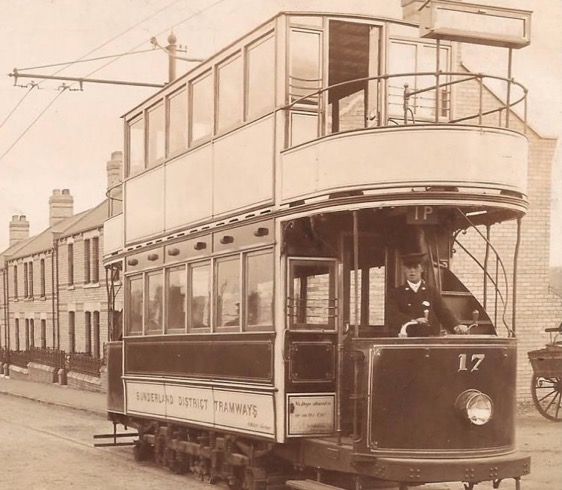
A motorman at the controls of a fairly new-looking No 17, one of the ill-fated French-built cars, in Burn Terrace — photo undated, but probably taken in 1905 or 1906. The subject is wearing a double-breasted jacket, which bears an oval badge on the left breast. Source unknown.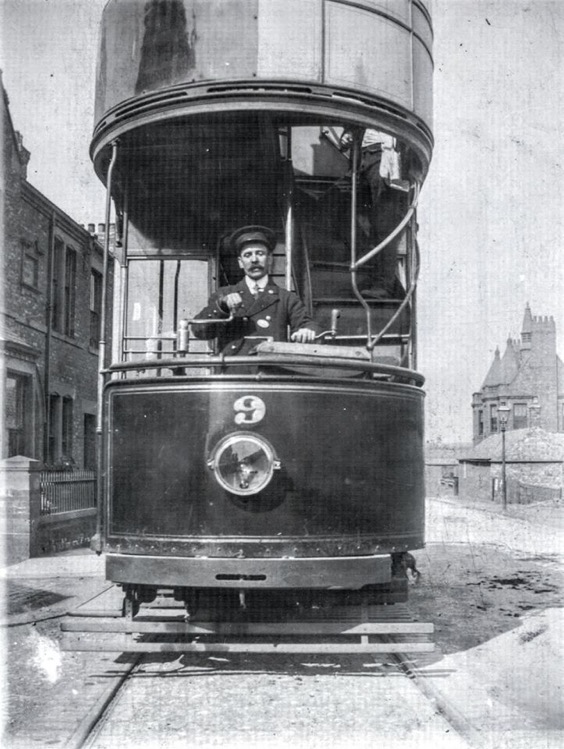
Tramcar No 9 captured in Station Rd, Hetton-le-Hole — photo undated, but given the good condition of the vehicle, probably taken late 1906 when the extension through the village was opened. The motorman is once again wearing a double-breasted jacket with an oval badge on his left breast. The cap does not appear to bear a badge. Photo courtesy of the Christopher Dean Collection.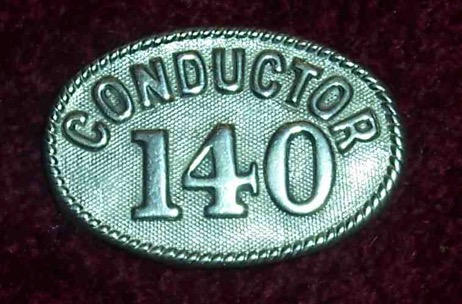
Conductor employee number badge of the pattern possibly used by the SDET — nickel. Author's Collection.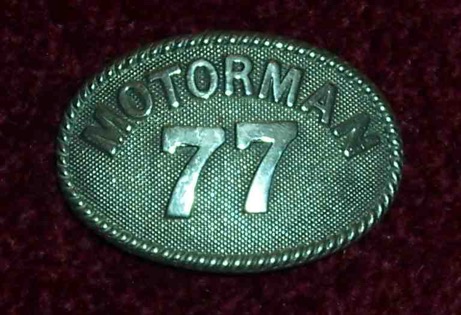
Motorman employee number badge of the pattern possibly used by the SDET — nickel. Author's Collection.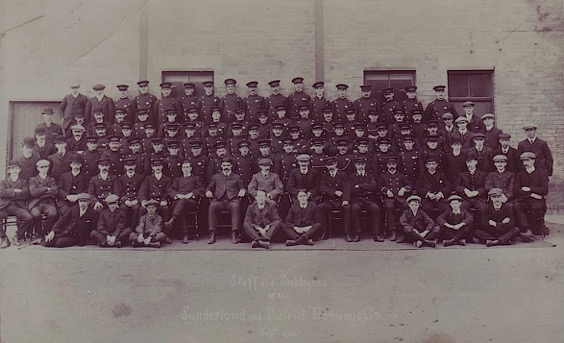
A staff photo taken in September 1908. All the uniformed staff, bar those at the front, are wearing 'lancer-style' tunics, many of them with the oval badge seen in the previous photos. The six men wearing double-breasted jackets (seated at the front) are inspectors. With thanks to Peter Searle.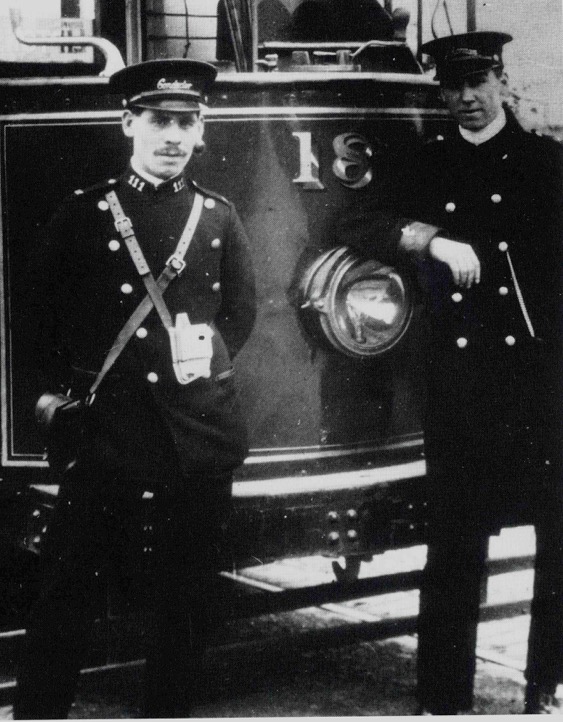
Conductor 111 and his motorman pose in front of Tramcar No 18 at Penshaw Station in 1911, with a service bound for Houghton-le-Spring. With thanks to Stephen Howarth.
Standard ‘off-the-shelf’ script-lettering cap badges of the type used by the SDET from 1905 through to the Great War — brass. Author's Collection.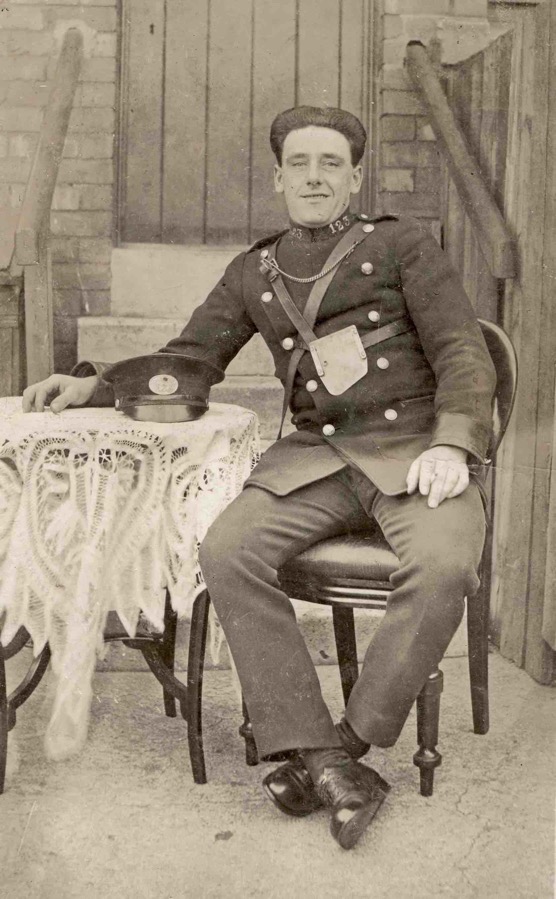
An evocative shot of an SDET conductor (Employee No 123) — photo undated, but from his hair style, probably taken in the mid-1920s or possibly even after the demise of the tramway. The subject was called Wilfred. Author's Collection.
Female staff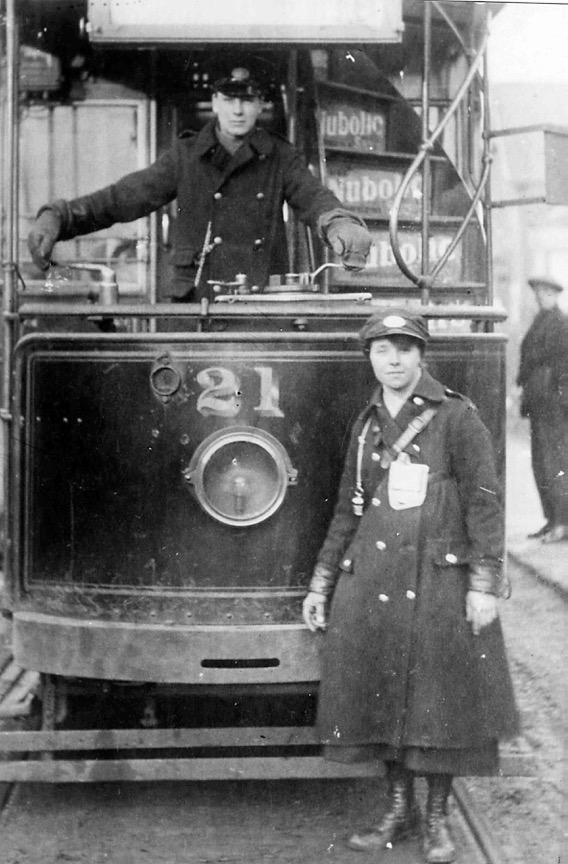
The crew of Tramcar No 21(2) at the Grangetown terminus on the south side of the junction with Ocean Road — photo undated, but probably taken between 1918 and 1920. Both employees are wearing large oval cap badges, which by this time had clearly superseded the standard script-lettering grade badges used earlier; it seems reasonably likely that these are the same badges that were previously worn on the left-breast of the uniform jackets. With grateful thanks to Malcolm Fraser.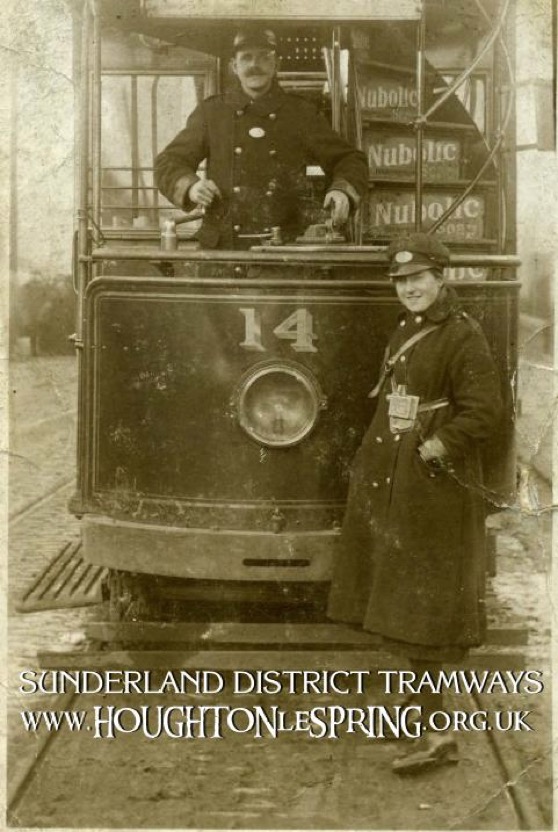
Another view of a tramcar crew at Grangetown terminus, this time with No 14 — photo undated, but probably taken between 1918 and 1920, possibly even on the same day as the photo above. The motorman is thought to be Peter James of Houghton-le-Spring, who is wearing the oval badge in the middle of his greatcoat. With thanks to Paul Lanagan.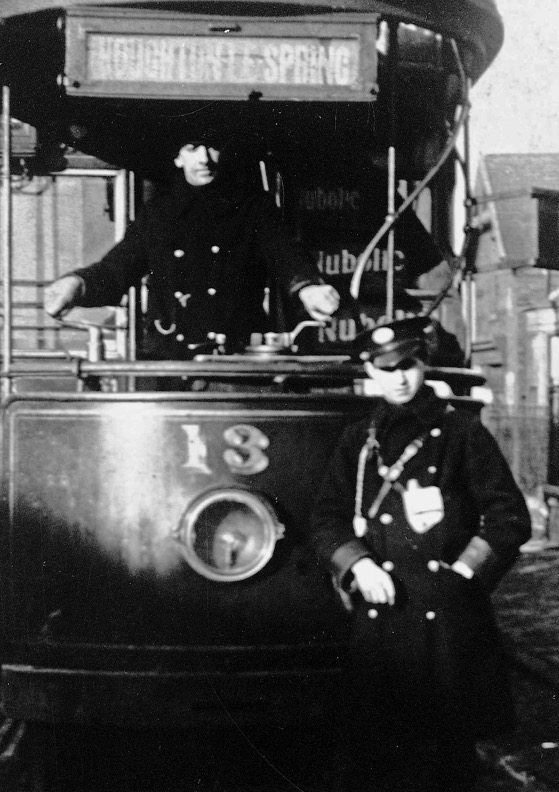
An S&DET tramcar crew posing with their vehicle (No 13) at the terminus in Ryhope Road, Grangetown. This was the second car to be numbered 13 — being delivered in December 1920 and withdrawn on 7th November 1924 — thus dating the photo to this period (my thanks go to Malcolm Fraser for this information). Both crewmen are wearing double-breasted greatcoats bearing five pairs of buttons. The conductor’s cap clearly bears the oval badge seen in previous photos. Note that the S&DET also ran buses, and indeed continued to run them — initially as the Sunderland and District Transport Co, then the Sunderland and District Omnibus Co — for half a century after the demise of the trams. Image kindly supplied by Beamish Museum Limited (see link), image copyright Beamish Museum Limited.